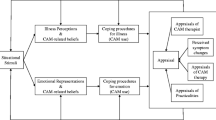Abstract
This study evaluated whether electrodermal resistance at acupuncture points (AP) systematically varies as a function of pain. The study was conceived as a proof-of-principle study in support of research on acupuncture and other complementary medicine approaches. Specifically, this study investigates whether or not electrodermal activity systematically differentiates arthritis patients with current pain from pain-free controls. Participants with rheumatoid arthritis (n = 32) and a typical pain level of at least 3 (on a 0–10 scale) were compared with case controls (n = 28) who had no medical diagnosis and were pain free. Electrodermal resistance at AP was measured with a commercial ohmmeter and compared to heart rate, blood pressure, and ratings on the Pain Catastrophization Scale and the McGill Melzack Pain Questionnaire. There were consistent differences between the experimental group and the control group on all markers of pain. Similarly, there were significant group differences and some trends for electrodermal activity at the AP labeled ‘bladder,’ ‘gall bladder,’ and ‘small intestine.’ It is concluded that the concept of electrodermal resistance at AP possesses criterion validity for distinguishing pain from a no pain state. This research provides support for the usefulness of measuring electrodermal activity when testing energy-based models of disease, and can be seen as a bridge between Western and Chinese medicine.
Similar content being viewed by others
References
Ahn, A. C., Schnyer, R., Conboy, L., Laufer, M. R., & Wayne, P. M. (2009). Electrodermal measures of jing-well points and their clinical relevance in endometriosis-related chronic pelvic pain. The Journal of Alternative and Complementary Medicine, 15, 1293–1305.
Brunton, L., Lazo, J., & Parker, K. (Eds.). (2006). Goodman and Gillman’s: The pharmacological basis of therapeutics (11th ed.). New York: McGraw-Hill Company.
Campbell, C. M., & Edwards, R. R. (2009). Mind-body interactions in pain: The neurophysiology of anxious and catastrophic pain-related thoughts. Translational Research, 153, 97–101.
Charlton, J. E. (Ed.). (2005). Core curriculum for professional education in pain. Seattle: IASP Press.
Chaves, J. F., & Brown, J. (1987). Spontaneous coping strategies for pain. Journal of Behavioral Medicine, 10, 263–276.
Colbert, A., Hammerschlag, R., Aickin, M., & McNames, J. (2004). Reliability of the prognos electrodermal device for measurement of electrical skin resistance at acupuncture points. The Journal of Alternative and Complementary Medicine, 10, 610–616.
Colbert, A., Hayes, M., Aickin, M., & Hammerschlag, R. (2006). Physiological variability of electrical skin resistance measurements at the ting acupuncture points. Medical Acupuncture, 17, 1–10.
Delaney, J. P. A., Leong, K. S., Watkins, A., & Brodie, D. (2002). The short-term effects of myofascial trigger point massage therapy on cardiac autonomic tone in healthy subjects. Journal of Advanced Nursing, 37, 364–371.
Garvey, T. A., Marks, M. R., & Wiesel, S. W. (1989). A prospective, randomized, double-blind evaluation of trigger-point injection therapy for low-back pain. Spine, 14, 962–964.
Graham, C., Bond, S., Gerkovich, M., & Cook, M. (1980). Use of the McGill pain questionnaire in the assessment of cancer pain: Replicability and consistency. Pain, 8, 377–387.
Hsin, H., Huang, S. M., Chao, P. T., Jan, M. Y., Hsu, T. L., Wang, W. K., et al. (2007). Microcirculatory characteristics of acupuncture points obtained by laser doppler flowmetry. Physiological Measurement, 28, N77–N86.
Jacox, A., Carr, D., & Payne, R. (1994). Management of cancer pain clinical practice guidelines, no 9, AHCPR.
Kao, F. F., & Kao, J. J. (1973). Acupuncture therapeutics. New Haven, Conn: Eastern Press.
Lo, S. Y. (2002). Meridians in acupuncture and infrared imaging. Journal of Medical Hypotheses, 58, 72–76.
Martinez-Lavin, M., & Hermosillo, A. G. (2000). Autonomic nervous system dysfunction may explain the multisystem features of fibromyalgia. Seminars in Arthritis and Rheumatism, 29, 197–199.
Mattu, G. S., Heran, B. S., & Wright, J. M. (2004). Overall accuracy of the BP tru an automated electronic BP device. Devices and Technology, 9, 47–52.
McCaffrey, M., & Pasero, C. (1999). Pain, clinical manual (2nd ed.). Toronto: Mosby.
Melzack, R. (1976). The Brompton mixture: Effects on pain in cancer patients. Canadian Medical Association Journal, 115, 125–129.
Melzack, R. (1987). The short-form McGill pain questionnaire. Pain, 30, 191–197.
Melzack, R., Stillwell, D. M., & Fox, E. J. (1977). Trigger points and acupuncture points for pain: Correlations and implications. Pain, 3, 3–23.
Rosenstiel, A. K., & Keefe, F. J. (1983). The use of coping strategies in chronic low back pain patients: Relationship to patient characteristics and current adjustment. Pain, 17, 33–44.
Schultz, S., Driban, J. B., & Swanik, C. B. (2007). The evaluation of electrodermal properties in the identification of myofascial trigger points. Archives of Physical Medicine Rehabilitation, 88, 780–784.
Schutze, R., Rees, C., Preece, M., & Schutze, M. (2010). Low mindfulness predicts pain catastrophizing in a fear-avoidance model of chronic pain. Pain, 148, 120–127.
Spanos, N., Brown, J., Jones, B., & Horner, D. (1981). Cognitive activity and suggestions for analgesia in the reduction of reported pain. Journal of Abnormal Psychology, 90, 554–561.
Sullivan, M. J. L., Bishop, S., & Pivik, J. (1995). The pain catastrophizing scale: Development and validation. Psychological Assessment, 7, 524–532.
Turk, D. (2001). Combining somatic and psychosocial treatment for chronic pain patients: Perhaps 1 + 1 = 3. Clinical Journal of Pain, 17, 281–283.
Turner, L., Linden, W., Talbot-Ellis, A., & Millman, R. (2010). Measurement reliability for acupoint activity determined with the Prognos ohmmeter. Applied Psychophysiology and Biofeedback, 35, 251–256.
Yang, H. Q., Xie, S. S., Liu, S. H., Li, H., & Guo, Z. Y. (2007). Differences in optical transport properties between human meridian and non-meridian. American Journal of Chinese Medicine, 35, 743–752.
Zhang, W., Jeong, D., Lee, Y., & Lee, M. S. (2004). Measurement of subcutaneous impedance by four-electrode method at acupoints located with single-power alternative current. American Journal of Chinese Medicine, 32, 779–788.
Author information
Authors and Affiliations
Corresponding author
Rights and permissions
About this article
Cite this article
Turner, L., Linden, W. & Marshall, C. Electrodermal Activity at Acupuncture Points Differentiates Patients with Current Pain from Pain-Free Controls. Appl Psychophysiol Biofeedback 38, 71–80 (2013). https://doi.org/10.1007/s10484-013-9209-6
Published:
Issue Date:
DOI: https://doi.org/10.1007/s10484-013-9209-6



